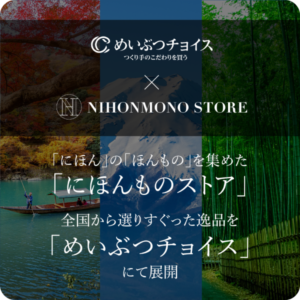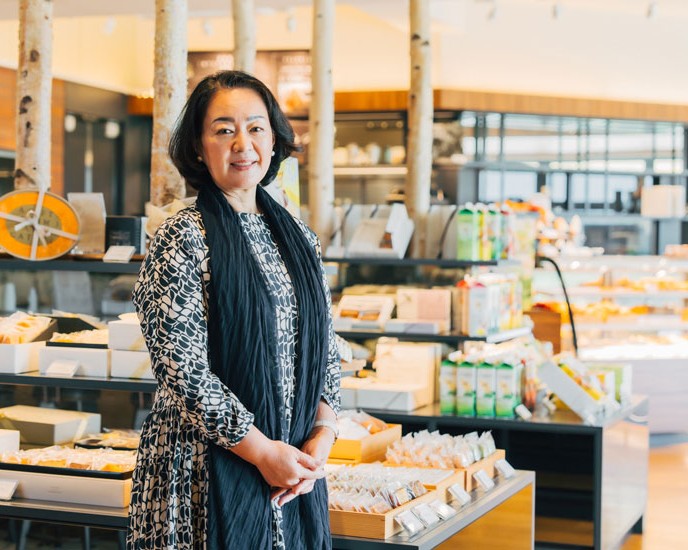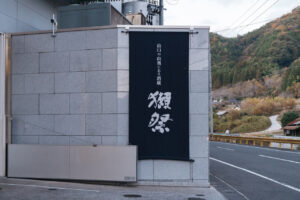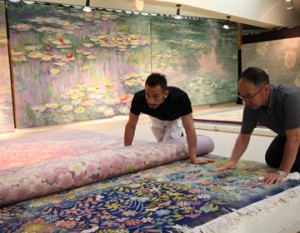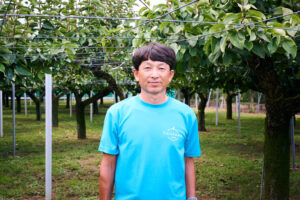Chateraise, headquartered in Yamanashi Prefecture, was founded as a small confectionary store by a complete amateur farmer who started out as a “helper. How did Chateraise grow and how will it continue to expand its “Japanese-style franchise” by adapting to the needs of the times and constantly making changes?
A path in business that began as a complete amateur.

YATSUDOKI TERRACE Ishiwa, a confectionery store, cafe, and hotel, is located in Isawa-cho, Fuefuki-shi, Yamanashi Prefecture, on the banks of the Fuefuki-gawa River, overlooking Mt. It is a nice place with a magnificent view,” says Takako Saito. Since assuming her current position in 2018, she has been working hard on new hotel business in addition to her existing business.
Shateraise began in 1954 when Takako’s father, Hiroshi Saito, and his brother opened a store selling Amataro, an Imagawa-yaki style confectionery, in Kofu City (formerly Koume-cho), Yamanashi Prefecture. However, the store did not take off, and Hiroshi was asked by his father to help his younger brother, so he joined the business that same year. As a full-time farmer until then, the world of business was an unknown territory for Hiroshi. He recalls, “I was anxious about starting out as a complete amateur.
As a result of Hiroshi’s help, the store gradually got off the ground and the number of stores increased. However, “Amataro,” which sold freshly baked goods, had a problem: While sales were good in the cold winter months, they were slow in the hot summer months. So, Hiroshi decided to start producing and selling ice cream as a summer solution.
However, when he built a factory and started production, he found that the ice cream market was mainly held by large manufacturers. No matter how hard he tried, he could not get a good sales space for his products, and his ice cream business eventually went into the red. Realizing that competing on the same footing as the major manufacturers was not going to work, Hiroshi sought a strategy. Noting that retailers had not yet installed refrigerators for fresh food at that time, he began research and development of “cream puffs,” believing that the major manufacturers would not be able to design a production plan for sweets that would not keep for a long period of time. In 1967, the company changed its name to Chateraise Corporation and began full-scale production of cream puffs.
He said, “I thought that if we didn’t have a refrigerator, we should sell out at a price that would sell out as soon as they were put on the shelves.
The company decided to set an inexpensive price that would be easy to pick up, and started selling them for 10 yen, whereas other companies were selling them for 50 yen apiece. This strategy paid off, and the product became Chateraise’s mainstay, with 500,000 units being manufactured daily.
A moment of confidence turned into certainty.

From its humble beginnings as a small store, Chateraise has grown to become one of the leading confectionery franchisees in Japan. A franchise is a business model in which an individual or corporation contracts with a business and pays a fee (royalty) for the right to sell the store name, products, and services.
The turning point for the company came when it was still specializing in “wholesale” sales of products to retailers in the prefecture. He gave advice on manufacturing methods to a confectionery store in the Kansai region with which he had a good relationship, and the business performance of the shop improved rapidly. His business performance improved rapidly, and eventually the company went public. His strong confidence that “our products can be accepted nationwide” led him to consider a franchise business. As a first step, he opened a directly managed store to sell products made at the factory directly to customers. At the store, which was tucked away in a field, Saito’s father, Hiroshi, began experimenting with wholesale prices, which could only be offered at a directly managed store. It was a challenge to the retail industry. Hiroshi’s enthusiasm resulted in a product that was 34% less expensive than other companies’ products, and was delivered to consumers.
In 1986, the company opened its first factory-operated store outside of Chiba Prefecture, where a subsidiary was located. The “inexpensive and delicious” Chateraise confectionery was an instant hit, and the directly operated stores were a huge success. This led to a succession of applications from all over Japan to open factory-operated stores, and the franchise business began to expand nationwide.
Franchise Circle Sticking to the “Japanese Way
The franchise business model originated in the U.S., and was not very familiar in Japan at the time. Mr. Saito emphasizes that the franchise model that Chateraise has stuck to is “not an imitation of the American model, but rather a Japanese model. The true reason for this was the innovative policy of “not charging royalties. Royalties are a kind of “usage fee” that comes with the granting of product and know-how rights, and in most cases, the user pays a few percent of the sales amount. However, the franchise business developed by Chateraise eliminates all of this. The conditions are that the customer bears the burden of preparing the funds, selecting the store, and other preparations for opening the business. The company also requires its franchisees to agree with the Chateraise philosophy of “three pleasure management”: first, to please customers, then to please suppliers, and finally to please employees. He says that he does not ask for anything more than that.
It’s not a business-like relationship,” he says. In the franchise business, it is very important to build a good relationship with the store owners. We value a ‘Japanese-style’ relationship in which we share corporate values through our philosophy, not through money.
Shateraise across the sea

Currently, Chateraise stores are located not only in Japan, but also in Indonesia, Singapore, Malaysia, Hong Kong, the United Arab Emirates, Thailand, Vietnam, and other parts of the world. There, too, the company is trying to share its management policy by communicating its “Japanese” franchise format of “associates, not business partners” and its “3Ki Management” philosophy.
Saito says that he was “surprised” to find that foreign people understood the “Japanese” philosophy very well and communicated with him in a sympathetic manner. The relationship of “friends” built by sharing not only products and signs, but also the philosophy of the company, continues to spread across the seas.
YATSUDOKI” for a taste of Chateraise that takes it up a notch.

In 2019, Chateraise’s newest development drew attention with the birth of its new “YATSUDOKI” brand, which is distinctly different from its existing product lineup. This premium brand, which sources freshly produced eggs directly from contracted farmers in Yamanashi Prefecture, is widely sought after as souvenirs and gifts for spending money. Originally, the company’s policy was to provide relatively inexpensive sweets that anyone could easily purchase, but Saito says that he was concerned that this would not create a need for gift items. That is when the idea of the “YATSUDOKI” brand was born.
The name “YATSUDOKI” is derived from “yatsudoki,” meaning “snack time” (3:00 p.m.), and the Chinese character for “eight” is also said to reflect the image of the majestic Yatsugatake mountains that rise in northern Yamanashi Prefecture. The “YATSUDOKI” products actually use ingredients grown in the fertile land at the foot of Mt. Yatsugatake, and the company works with farms and ranches that share its desire to create delicious confections, thoroughly discussing the fields, soil, livestock feed, and other aspects of product development. They work together with farms and ranches that share their desire to make delicious confections, thoroughly discussing everything from fields and soil to livestock feed. Currently, as “Chateraise on a higher level,” the company has opened a series of stores in Miyagi, Saitama, Tokyo, Kanagawa, Yamanashi, Nagano, Kyoto, Hyogo, and other prefectures.
The future of Chateraise

In recent years, the confectionery industry has been in a difficult situation, with rising raw material and transportation costs being a hot topic. The producers who make the ingredients for confectionery are in the toughest situation.
“When I’m in Yamanashi, I can understand the plight of the producers. I think it’s not limited to the prefecture. I think there is a lot that needs to be done to make better products. In order to help them, I would like to first try new things in Yamanashi, where we are based, and spread the theory I have gained there to other places.”
Saito says that he is focusing on “automation” as a challenge to tackle in the future. He talks about future developments, saying, “By challenging ourselves to create fundamental systems, such as building a new system for factory production and introducing automatic ordering using AI, we would like to explore ways to maintain quality without having to take the plunge and reduce raw material costs.” Chateraise’s challenge will eventually help producers. It is exactly the “3 joys management” that is the philosophy of the company.

He said that he has been told unkindly that the mechanization of the production line “can’t compete with sweets made by hand.” He prefaced his statement by saying, “Of course, there are some things that can’t be competed with by human hands,” but he flatly denied the negative comments, saying, “Even so, we seek technical guidance from top-level pastry chefs, and study every day to see how we can get as close to their techniques as possible with machine production, and to make sweets that are the same as handmade sweets, thereby improving our technical level.”
“We can’t keep up with the times unless we make such major reforms.”
Chateraise has grown significantly by constantly brushing up its business model, such as the manufacture of Western confectionery, franchise business, and the establishment of a premium brand, by sensitively sensing the changes of the times. Without stopping its flexible attitude to ride the times, it is aiming for an even greater leap forward in the face of adversity.
